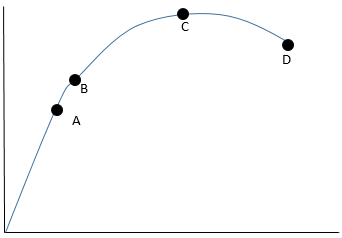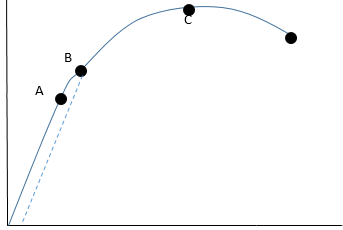This set of Mechanical Metallurgy Multiple Choice Questions & Answers (MCQs) focuses on “Tension Test – True-Stress-True Strain Curve – 1”.
1. The Offset yield strength point is shown as ___________________

a) A
b) B
c) C
d) D
View Answer
Explanation: The offset yield point is generally defined as 0.2% strain. The figure is shown below.

2. Which of the two curves will have the same shape?
a) Load-elongation and engineering stress-strain
b) Load-elongation and true stress-strain
c) Engineering stress-strain and true stress-strain
d) Uniaxial tension and uniaxial torsion
View Answer
Explanation: Both the load vs. elongation and engineering stress vs. engineering strain curve uses the first area of the specimen in the calculation. So the shape of the curve is the same.
3. Which of the following is the strength parameter of any material?
a) Percentage elongation
b) Reduction in area
c) Yield stress
d) Necking area
View Answer
Explanation: The yield stress/strength defines the strength of the material to withstand the elastic deformation. The rest of the parameter represents the ductility of the material.
4. The highest strain value is obtained at ___________
a) true elastic limit
b) propositional limit
c) yield point
d) elastic limit
View Answer
Explanation: The true elastic limit is a point related with very low value and is related to the motion of a few hundred dislocations. The proportional limit is the largest stress at which stress is directly proportional to strain. Elastic limit is the highest stress that the material can withstand without any measurable permanent strain remaining. The yield point is the point associated with the stress required to produce a small specified amount of plastic deformation.
5. The yield strength with an offset limit of 0.2 strain, is a universally accepted property of the material.
a) True
b) False
View Answer
Explanation: The yield point defines the point in the curve where we observe a slight amount of plastic deformation. For the convenience and standard, it is set at 0.2 strain value.
6. Which of the following parameter is used as designing material of components?
a) Proof stress
b) Propositional limit
c) True elastic limit
d) Elastic limit
View Answer
Explanation: The proof stress also called the yield strength, is defined as the value of stress, which causes 0.2% elongation or permanent deformation in the material. It is the parameter used in designing of component and to avoid failure due to excessive loading.
7. Which of the following material does not have a linear portion in the stress-strain curve?
a) Steel
b) Magnesium
c) Grey cast iron
d) Aluminum
View Answer
Explanation: The grey cast iron and soft copper are among few exceptions, where there is no linear portion in stress-strain curve exists.
8. Which is the most important property used in the rolling process?
a) Toughness
b) Hardness
c) Resilience
d) Ductility
View Answer
Explanation: The ability of the material to deform plastically is majorly decided by its ductility. In the rolling process, the material is deformed in between roll plastically, so the ductility of material has to be kept in mind to avoid the fracture of the material.
9. The percentage of elongation is a material-specific property.
a) True
b) False
View Answer
Explanation: The percentage elongation depends on the material and also on the initial gauge length. If the gauge length is smaller, the percentage elongation will be higher for the same material having more larger gauge length.
Sanfoundry Global Education & Learning Series – Mechanical Metallurgy.
To practice all areas of Mechanical Metallurgy, here is complete set of 1000+ Multiple Choice Questions and Answers.
If you find a mistake in question / option / answer, kindly take a screenshot and email to [email protected]
- Check Mechanical Metallurgy Books
- Check Metallurgical Engineering Books
- Practice Metallurgical Engineering MCQs
- Apply for Metallurgical Engineering Internship
